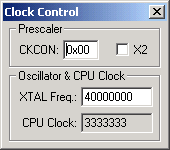|
||
| Products Download Events Support Videos | ||
Product Information
Device Database®
Downloads
Compliance Testing
Distributors
Peripheral Simulation
For Atmel AT89C51RB2 — X2 Mode for CPU with Clock Control
Simulation support for this peripheral or feature is comprised of:
- Dialog boxes which display and allow you to change peripheral configuration.
- VTREGs (Virtual Target Registers) which support I/O with the peripheral.
These simulation capabilities are described below.
Clock Control Dialog

PORTx VTREG
Data Type: unsigned char
The PORTx VTREGs represent the I/O pins of the simulated MCU for Port 0, Port 1, and so on. PORT0 represents Port 0, PORT1 represents Port 1, etc. You may read PORTx to determine the state of the output pins of that port. For example, in the command window, you may type,
PORT0
to obtain value corresponding to the set pins of Port 0. You may also change the input values of port pins by changing the value of the VTREG. For example,
PORT1=0xF0
sets the upper four port pins of Port 1 to a value of 1 and the lower 4 port pins to a value of 0. You may use the bitwise operators AND(&), OR(|) and XOR(^) to change individual bits of the PORTx VTREGs. For example:
PORT1 |= 0x01; /* Set P1.0 Pin */ PORT3 &= ~0x02; /* Clr P3.1 Pin */ PORT1 ^= 0x80; /* Toggle P1.7 Pin */
XTAL VTREG
Data Type: unsigned long
The XTAL VTREG contains the frequency of the oscillator (in Hertz) used to drive the microcontroller. The value is automatically set from the value specified in Project Options - Options for Target. However, you may change the value of XTAL using the command window. For example:
XTAL=12000000
You may also output the current value of XTAL using the following:
XTAL
XTAL may be used in calculations to synchronize external scripts with the simulated microcontroller.
ProductsDevelopment Tools |
Hardware & Collateral |
Downloads |
Support |
Contact |
